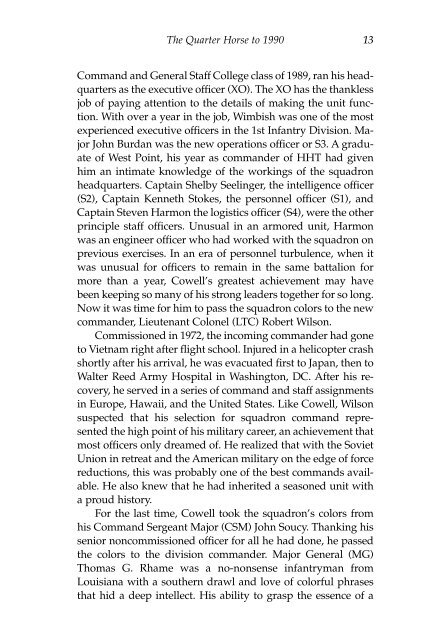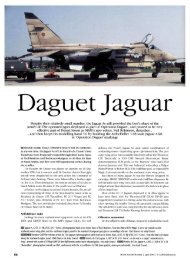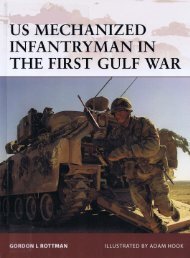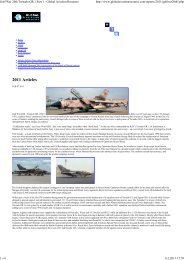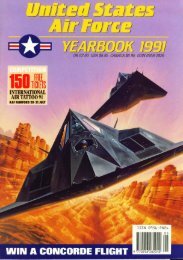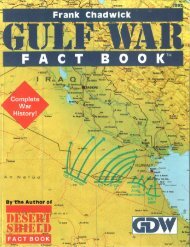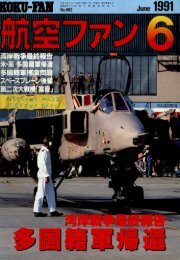The Road to Safwan: The 1st Squadron, 4th Cavalry in the 1991 ...
The Road to Safwan: The 1st Squadron, 4th Cavalry in the 1991 ...
The Road to Safwan: The 1st Squadron, 4th Cavalry in the 1991 ...
You also want an ePaper? Increase the reach of your titles
YUMPU automatically turns print PDFs into web optimized ePapers that Google loves.
<strong>The</strong> Quarter Horse <strong>to</strong> 1990 13<br />
Command and General Staff College class of 1989, ran his headquarters<br />
as <strong>the</strong> executive officer (XO). <strong>The</strong> XO has <strong>the</strong> thankless<br />
job of pay<strong>in</strong>g attention <strong>to</strong> <strong>the</strong> details of mak<strong>in</strong>g <strong>the</strong> unit function.<br />
With over a year <strong>in</strong> <strong>the</strong> job, Wimbish was one of <strong>the</strong> most<br />
experienced executive officers <strong>in</strong> <strong>the</strong> <strong>1st</strong> Infantry Division. Major<br />
John Burdan was <strong>the</strong> new operations officer or S3. A graduate<br />
of West Po<strong>in</strong>t, his year as commander of HHT had given<br />
him an <strong>in</strong>timate knowledge of <strong>the</strong> work<strong>in</strong>gs of <strong>the</strong> squadron<br />
headquarters. Capta<strong>in</strong> Shelby Seel<strong>in</strong>ger, <strong>the</strong> <strong>in</strong>telligence officer<br />
(S2), Capta<strong>in</strong> Kenneth S<strong>to</strong>kes, <strong>the</strong> personnel officer (S1), and<br />
Capta<strong>in</strong> Steven Harmon <strong>the</strong> logistics officer (S4), were <strong>the</strong> o<strong>the</strong>r<br />
pr<strong>in</strong>ciple staff officers. Unusual <strong>in</strong> an armored unit, Harmon<br />
was an eng<strong>in</strong>eer officer who had worked with <strong>the</strong> squadron on<br />
previous exercises. In an era of personnel turbulence, when it<br />
was unusual for officers <strong>to</strong> rema<strong>in</strong> <strong>in</strong> <strong>the</strong> same battalion for<br />
more than a year, Cowell’s greatest achievement may have<br />
been keep<strong>in</strong>g so many of his strong leaders <strong>to</strong>ge<strong>the</strong>r for so long.<br />
Now it was time for him <strong>to</strong> pass <strong>the</strong> squadron colors <strong>to</strong> <strong>the</strong> new<br />
commander, Lieutenant Colonel (LTC) Robert Wilson.<br />
Commissioned <strong>in</strong> 1972, <strong>the</strong> <strong>in</strong>com<strong>in</strong>g commander had gone<br />
<strong>to</strong> Vietnam right after flight school. Injured <strong>in</strong> a helicopter crash<br />
shortly after his arrival, he was evacuated first <strong>to</strong> Japan, <strong>the</strong>n <strong>to</strong><br />
Walter Reed Army Hospital <strong>in</strong> Wash<strong>in</strong>g<strong>to</strong>n, DC. After his recovery,<br />
he served <strong>in</strong> a series of command and staff assignments<br />
<strong>in</strong> Europe, Hawaii, and <strong>the</strong> United States. Like Cowell, Wilson<br />
suspected that his selection for squadron command represented<br />
<strong>the</strong> high po<strong>in</strong>t of his military career, an achievement that<br />
most officers only dreamed of. He realized that with <strong>the</strong> Soviet<br />
Union <strong>in</strong> retreat and <strong>the</strong> American military on <strong>the</strong> edge of force<br />
reductions, this was probably one of <strong>the</strong> best commands available.<br />
He also knew that he had <strong>in</strong>herited a seasoned unit with<br />
a proud his<strong>to</strong>ry.<br />
For <strong>the</strong> last time, Cowell <strong>to</strong>ok <strong>the</strong> squadron’s colors from<br />
his Command Sergeant Major (CSM) John Soucy. Thank<strong>in</strong>g his<br />
senior noncommissioned officer for all he had done, he passed<br />
<strong>the</strong> colors <strong>to</strong> <strong>the</strong> division commander. Major General (MG)<br />
Thomas G. Rhame was a no-nonsense <strong>in</strong>fantryman from<br />
Louisiana with a sou<strong>the</strong>rn drawl and love of colorful phrases<br />
that hid a deep <strong>in</strong>tellect. His ability <strong>to</strong> grasp <strong>the</strong> essence of a


